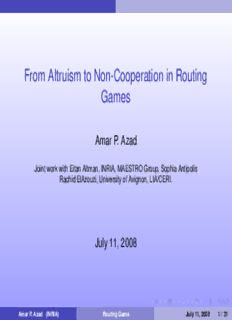
From Altruism to Non-Cooperation in Routing Games PDF
Preview From Altruism to Non-Cooperation in Routing Games
From Altruism to Non-Cooperation in Routing Games AmarP.Azad JointworkwithEitanAltman,INRIA,MAESTROGroup,SophiaAntipolis RachidElAzouzi,UniversityofAvignon,LIA/CERI. July 11,2008 AmarP.Azad (INRIA) RoutingGame July11,2008 1/31 Outline Outline 1 ModelandProblemFormulation RoutingGame CooperationParadigm ProblemFormulation NetworkTopologywith Cooperation 2 NumericalInvestigation Experiments ObservationsSummary 3 Existence andUniquenessofNEP Assumptions 4 Summary AmarP.Azad (INRIA) RoutingGame July11,2008 2/31 Outline Outline 1 ModelandProblemFormulation RoutingGame CooperationParadigm ProblemFormulation NetworkTopologywith Cooperation 2 NumericalInvestigation Experiments ObservationsSummary 3 Existence andUniquenessofNEP Assumptions 4 Summary AmarP.Azad (INRIA) RoutingGame July11,2008 2/31 Outline Outline 1 ModelandProblemFormulation RoutingGame CooperationParadigm ProblemFormulation NetworkTopologywith Cooperation 2 NumericalInvestigation Experiments ObservationsSummary 3 Existence andUniquenessofNEP Assumptions 4 Summary AmarP.Azad (INRIA) RoutingGame July11,2008 2/31 Outline Outline 1 ModelandProblemFormulation RoutingGame CooperationParadigm ProblemFormulation NetworkTopologywith Cooperation 2 NumericalInvestigation Experiments ObservationsSummary 3 Existence andUniquenessofNEP Assumptions 4 Summary AmarP.Azad (INRIA) RoutingGame July11,2008 2/31 ModelandProblemFormulation RoutingGame Outline 1 ModelandProblemFormulation RoutingGame CooperationParadigm ProblemFormulation NetworkTopologywith Cooperation 2 NumericalInvestigation Experiments ObservationsSummary 3 Existence andUniquenessofNEP Assumptions 4 Summary AmarP.Azad (INRIA) RoutingGame July11,2008 3/31 ModelandProblemFormulation RoutingGame System Model Network: a graphG =(V,L) V isasetofnodes L⊆V ×V issetofdirectedlinks. I = {1,2,...,I} is a set ofuserswhich share thenetworkG. fi= flowofuseri in linkl . l Eachuseri hasa throughputdemandrate ri (which can besplit amongvariouspath). Strategy: fi = (fi) isthe routingstrategy ofuseri. l l∈L Assumptions: Atleastonelink exist betweeneach pairofnodes(ineach direction). Flowispreservedatall nodes. AmarP.Azad (INRIA) RoutingGame July11,2008 4/31 ModelandProblemFormulation RoutingGame Nash Equilibrium Cost/Utility function Ji(f) = fiT(f). l l l l Eachuserseeks to minimize thePcost function Ji, which dependsupon routingstrategy ofuseri as wellas onthe routingstrategy ofother users. NashEquilibrium Avector˜fi,i = 1,2,...,I iscalledaNashequilibriumifforeachuseri,˜fi minimizesthecost function giventhatotherusers’routing decisions are˜fj, j 6= i. In otherwords, J˜i(˜f1,˜f2,...,˜fI)= minJˆi(˜f1,˜f2,...,fi,...,˜fI), fi∈Fi i = 1,2,...,I , (1) whereFi is the routingstrategy spaceofuser i. AmarP.Azad (INRIA) RoutingGame July11,2008 5/31 ModelandProblemFormulation RoutingGame Network Topology Considerthe followingnetworktopology LoadBalancingNetwork ParallelLinkNetwork 3 2 l1 l2 l3 l l2 r11 l4 r22 1 1 r1 r2 Jˆi = fiT(f) l l l l∈{X1,...4} Jˆi = fliTl(fl) l∈X{1,2} AmarP.Azad (INRIA) RoutingGame July11,2008 6/31 ModelandProblemFormulation RoutingGame Cost Function Considerthe followingCost function. LinearCostFunction M/M/1 DelayCostFunction Used in Transportation Used in Queueing Networks Networks Ti =l(fl1i),2=,awihflie+regaisfo,r link Tl(fli) = Cli1−fli ,wherethe C andf denotethetotal l l T(f ) = cf +d forlink i i l l l capacity andtotalflow of j j j = 3,4. the link l. i Forparallellink topologyonlylinkl, i = 1,2 exist whilefor load i balancingtopologylink l,i = 3,4 also exist. i AmarP.Azad (INRIA) RoutingGame July11,2008 7/31
Description: